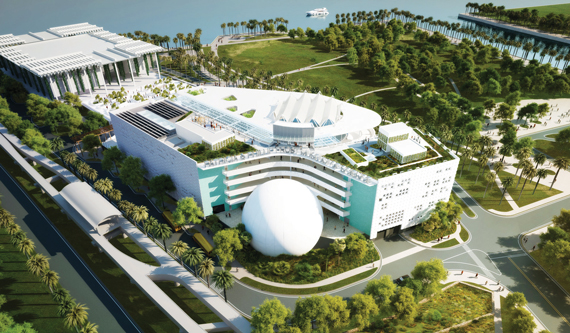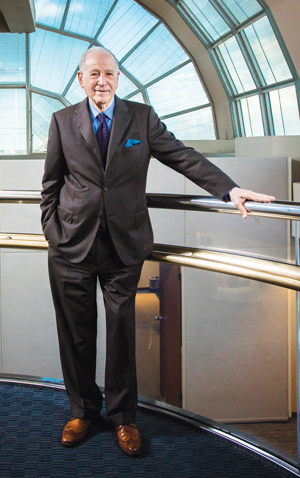As you fly into Miami from the west, you might be able to pick out the Patricia and Phillip Frost Art Museum on the campus of Florida International University. If you fly in from the east, you’ll see the nearly completed Patricia and Phillip Frost Science Museum, hugging the shoreline of Biscayne Bay in downtown Miami. If you visit the bucolic campus of the University of Miami, you can attend a concert or sit in on recitals at the Frost School of Music, known for its noted jazz program.
And it’s the Frosts’ hope that in a few years, students, scientists and researchers will be pushing the envelope of scientific research at the Frost Institutes for Science and Engineering at UM. In January, the couple announced a $100 million gift to fund the new endeavor, which they hope will turn Miami into a world-class science and technology destination.
For more than 40 years, Dr. Phillip Frost, the former chairman of the department of dermatology at Mt. Sinai Hospital in Miami Beach, has been a pharmaceutical entrepreneur, helping to establish the generic pharmaceuticals business with IVAX, a company he sold to Teva pharmaceuticals just over a decade ago for $7.4 billion. His wife, Patricia, was the principal of the Henry S. West Laboratory School, an innovative public elementary school on the UM campus.
Phillip Frost is currently the chairman and CEO of OPKO Health, a pharmaceutical company that is focused on developing drug treatment and diagnostic products in the areas of kidney disease and prostate cancer detection. The company has developed Rayaldee, a drug that raises Vitamin D levels in patients with kidney disease. OPKO has also developed 4Kscore, a blood test that can accurately detect the presence of prostate cancer.
Frost recently sat down with The Real Deal to discuss his hopes for Miami’s future as a leading city in science and technology innovation.
What was behind your gift to create the Frost Institutes for Science and Engineering?
It is part of a larger interest in helping Miami develop a bigger and better infrastructure in the sciences, technology and mathematics. Specifically with respect to the University of Miami, we would like to expand and move to an even higher level the scientific activities there. They have many good people, but we would like to increase the scope and the breadth and the number of top scientists working there who will in turn bring graduate students, who eventually may go on to work elsewhere, but a certain number of them may go on to form companies here. I think a critical mass is needed in order for an area to become known as a technology hub, and that is what we are trying to encourage.
You and your wife, Patricia, are also helping to fund the new Frost Science Museum with a $45 million gift. The museum will have an aquarium and a planetarium. What sort of science do you want to see the museum promote?
We want to make it very broad-based. We want to have strong emphasis on the biological sciences, with respect to human health and how the body functions, but we also want people to come in and learn more basic science, what we are made of, and of course we are interested in having them learn about our universe, our planets, aviation and transportation … in general what makes things work.

The Frost Science Museum (Rendering courtesy of Patricia and Phillip Frost Museum of Science)
Last year the museum faced a funding gap, and Miami-Dade County had to step in and provide about $49 million in emergency funds to get construction of the facility finished in time to open this year. The root of those problems was a shortfall in private donations. Why do you think that happened?
I would express it slightly differently. I would say that [private benefactors] were a little late in coming on board. But we think that as time goes on, they are going to be very anxious to be a part of it.
You are originally from Philadelphia, a city that has a long tradition of benefactors donating their fortunes to public institutions. Would you like to see more of that sort of philanthropy here in Miami?
It is a relatively new city, and there has been a tradition of giving, but the number of
people capable of making larger gifts has been relatively small. Now that is growing daily, and I think the tradition of making major gifts is about to take off.
You arrived in Miami just over 50 years ago to practice medicine. What has been notable about the growth of Miami to you over the past half century?
What has been most interesting is to see the growth in terms of development, the real estate projects, for example, but also the growth of individuals — the large number of people who have made successes of themselves in so many different areas — whether it is banking or real estate or technical areas. Most of them started as family businesses, and many of them still are. Others have become public companies, and the developers have accumulated large fortunes, so that bodes well for the community. It’s been a pleasure to watch this, and especially so because many of them are immigrants. It’s been a place that’s been very open to the ambitions of new arrivals.
So now when you travel, do you find people asking about moving their companies or their company headquarters here?
The truth is, we see that more and more. Miami is being looked upon as an ideal place to live, especially with what is going on with the turmoil in other parts of the world.
The growth of the arts has exploded in Miami in recent years. Art Basel, for example, has changed the face of downtown Miami and helped spur the development of the Wynwood neighborhood. Has this brought new people to the city?
It’s brought a lot of serious collectors to the area, both to visit and some to stay. We are now a hotbed of activity for the artistic world. From our personal point of view, we are very happy to have been a sponsor of the Frost Art Museum.
But the point is that on the one side, you have technology and science, but I don’t think the humanities should be neglected either. That is an important part of not only education but of the culture of a city and a country.
